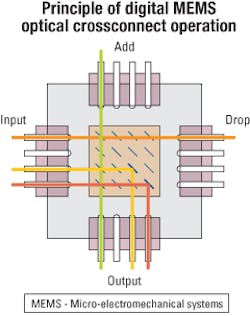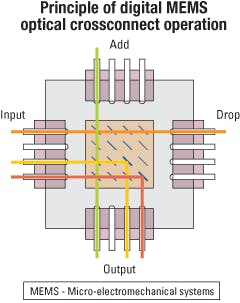Manufacturability and reliability verification based on digital MEMS
Micro-electromechanical systems have emerged as the most promising technology for building large-port-count optical switches.
PETER DE DOBBELAERE, OMM
Several companies recently have shown that silicon-based optical micro-electromechanical systems (MEMS) have emerged as the technology platform of choice for low-cost and scalable photonic applications. That's because it allows mass manufacturing of highly accurate miniaturized parts and uses materials with excellent mechanical and electrical properties (e.g., silicon, silicon oxide, and silicon nitride). The actuation forces that make MEMS move may be electrostatic, electromagnetic, or thermal. Silicon-based MEMS devices can be made with different process technologies, including bulk micro-machining (the mechanical structures are etched in single crystal silicon) and surface micro-machining (epitaxial layers of polysilicon, silicon nitride, and silicon oxide are deposited and patterned).
MEMS design configurations for optical switches can be divided into two groups: digital and analog. In both cases, micro-mirrors are actuated to redirect light from a given input port to a given output port. In digital switches, the mirror can only be in one of two states. In analog switches, two mirrors are independently tilted to obtain the switch function. In digital switches, a complex and expensive feedback system is required to maintain the position of each mirror over time and during external disturbances. With digital MEMS, no control circuitry is required, making the interface very straightforward. A typical MEMS mirror arrangement and principle of operation of a digital optical crossconnect is shown in the Figure. Of the different actuation forces used to move the mirrors, electrostatic actuation is the most advantageous, since it is straightforward to shield the switch from external influences (e.g., electric fields) and because of the extremely low power dissipation, which is on the order of a few microwatts for the complete matrix.
Manufacturing processesHigh-volume and high-yield production of optical components requires the development of suitable manufacturing processes with appropriate process monitoring. In addition, automation is highly desirable not only for increasing throughput, but also to increase consistency and yield by eliminating human interactions. The manufacturing process starts with a wet etch step for the MEMS chips, removing silicon oxide sacrificial layers and "releasing" the polysilicon structures. Subsequently, the polysilicon structures on the MEMS chips are assembled and locked, forming the optical-switch mechanism. In the next step, collimators (assemblies of optical fibers and lenses) are coupled with the MEMS chip, using automated alignment algorithms for active alignment. After fixation of the collimators, the housing can be hermetically sealed. To obtain a low-humidity atmosphere inside the package, a bake-out prior to sealing is required. Testing of the finished optical switch is the final step in the manufacturing process and includes hermeticity testing as well as a full parametric characterization.The most important performance parameters of an optical switch are insertion loss, crosstalk, repeatability, polarization-dependent loss, switch time, and return loss. Both switch time and repeatability are unique for optical switches.
Parametric characterization of large-port-count optical switches in a manufacturing environment is challenging. It requires the measurement of all the performance parameters for each of the interconnection paths. For example, manual characterization of a 16x16 optical-crossconnect switch takes more than 48 hours. The large number of single-fiber fusion splices required for many of the tests is a major contributor to the test time. But by clever automation and the use of fiber ribbon splicing, the test time can be reduced to less than 1.5 hours.
MEMS reliability
In the last few years, numerous MEMS designs and processes have been proposed for fiber-optic applications. It is clear that reliability strongly depends on the detailed design of the structures as well as the technologies used to fabricate them.
In addition to the silicon MEMS, other parts of the optical switch may have an impact on device reliability. The need for a hermetic housing with a large number of fiber feed-throughs is especially challenging for large-port-count optical MEMS switches. The hermetic seal must prevent any ingress of moisture into the package. Seals based on solder or glass can meet this requirement. If any adhesives are used in the manufacturing of the device, they must guarantee long-term stable fixation of the optical parts as well as prevent contamination of the environment inside the package.
Reliability testing and investigation must start at the beginning of the design phase to expose any potential weaknesses of the design. This approach eliminates many failure modes early in the design process. Once sufficient design and process iterations for optimized performance and reliability have been carried out, the design and manufacturing processes can be frozen. At this moment, qualification and reliability verification testing can begin. The outcomes of these tests are estimates for the median life and failure rate, a demonstration of environmental stability, and the robustness of the optical switch as well as feedback for the design and manufacturing engineers regarding performance and reliability.
To qualify components and subsystems for use in telecommunications systems, Telcordia Generic Requirements are often used as guidelines. Additional long-term tests and investigations are required for devices based on new technologies such as optical MEMS.
Qualification tests
Device qualification tests based on Telcordia's "Generic Requirements for Singlemode Fiber-optic Switches" cover both endurance and mechanical robustness tests. The endurance tests include long-term damp heat exposure, high-temperature aging, and low-temperature storage.
Mechanical robustness tests include fiber integrity testing, mechanical shock, mechanical vibration, humidity, thermal cycling, and thermal shock. Each of these tests must be performed on a statistically meaningful sample, often a "lot tolerance percent defective" of 20% is required, meaning that in a sample of 11 switches, none may fail during the test.
Static and dynamic reliability
Static reliability of a digital switch concerns the ability to alter states after it has remained in the same state for a long time. The associated failure mode is often referred to as "stiction." Dynamic reliability concerns the ability of the switch to perform a large number of switch cycles, also called durability. Both static and dynamic reliability are strongly dependent on the detailed design of the MEMS structures.
It is complicated to estimate the static reliability of all types of optical switches, because there are no clear accelerating mechanisms that allow extrapolation toward normal-use conditions. The best approach, therefore, is to undergo testing of the switches for a lengthy period of time and switch them at certain time intervals.
Telcordia requires this test to be performed over time intervals ranging from 168 hours up to 5,000 hours. It is recommended to extend these tests over a considerable period of time and test a large quantity of devices to verify a low failure rate over the expected life of 20 years.
One million failure-free switch cycles are often required for dynamic reliability-equivalent to operation over 20 years in which each switch path is cycled every 10 minutes. By eliminating mechanical contact between the moving parts of the MEMS structure, excellent performance in excess of 10 million cycles has been obtained for digital MEMS optical switches.
Peter De Dobbelaere is director of quality and reliability at OMM Inc. (San Diego). He can be reached via the company's Website, www.omminc.com.
Reference
- GR-1073-CORE: Telcordia Technologies, "Generic Requirements for Singlemode Fiber-optic Switches," Issue 1, January 2001.

